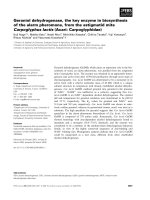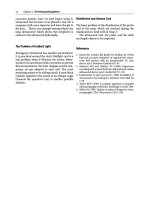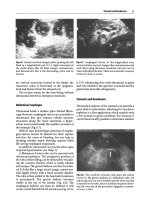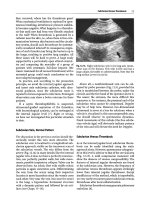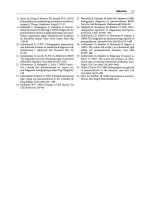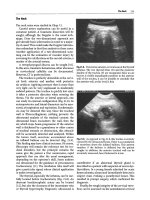Ebook Key topics in management of the critically ill: Part 1
Bạn đang xem bản rút gọn của tài liệu. Xem và tải ngay bản đầy đủ của tài liệu tại đây (2.54 MB, 112 trang )
Key Topics in
Management of
the Critically
Marcela P. Vizcaychipi
Carlos M. Corredor
Editors
123
Key Topics in Management
of the Critically Ill
Marcela P. Vizcaychipi • Carlos M. Corredor
Editors
Key Topics in
Management
of the Critically Ill
Editors
Marcela P. Vizcaychipi
Anaesthesia and Intensive Care Medicine
Chelsea and Westminster Hospital
London
UK
Carlos M. Corredor
Cardiothoracic Anaesthesia and Intensive
St George’s Hospital
London
UK
ISBN 978-3-319-22376-6
ISBN 978-3-319-22377-3
DOI 10.1007/978-3-319-22377-3
(eBook)
Library of Congress Control Number: 2015954553
Springer Cham Heidelberg New York Dordrecht London
© Springer International Publishing Switzerland 2016
This work is subject to copyright. All rights are reserved by the Publisher, whether the whole or part of
the material is concerned, specifically the rights of translation, reprinting, reuse of illustrations, recitation,
broadcasting, reproduction on microfilms or in any other physical way, and transmission or information
storage and retrieval, electronic adaptation, computer software, or by similar or dissimilar methodology
now known or hereafter developed.
The use of general descriptive names, registered names, trademarks, service marks, etc. in this publication
does not imply, even in the absence of a specific statement, that such names are exempt from the relevant
protective laws and regulations and therefore free for general use.
The publisher, the authors and the editors are safe to assume that the advice and information in this book
are believed to be true and accurate at the date of publication. Neither the publisher nor the authors or the
editors give a warranty, express or implied, with respect to the material contained herein or for any errors
or omissions that may have been made.
Printed on acid-free paper
Springer International Publishing AG Switzerland is part of Springer Science+Business Media
(www.springer.com)
Foreword
Intensive care medicine is a rapidly evolving specialty. In the last decade, there have
been advances in technology, diagnostics, treatment and in our understanding of the
pathogenesis of diseases that affect critically ill patients. Management of conditions
such as burns, stroke, acute liver failure, thromboembolism and delirium have
changed dramatically over the last few years with new diagnostic and therapeutic
modalities. These topics are eloquently covered in the relevant chapters in Key
Topics in Management of the Critically Ill.
Physical and neuropsychological rehabilitation after intensive care has been
another area of specific interest to the intensive care community over the last few
years and covered in the chapter on Neuropsychological Rehabilitation for Critically
Ill Patients. Published literature report approximately 30 % of patients suffer from
anxiety, 20 % of patients suffer from depression and up to 60 % of patients suffer
from post-traumatic stress disorder after intensive care admission with the associated long-term socio-economic consequences. Whereas historically intensive care
physicians were satisfied to leave follow-up care of these patients to the community,
there is now increasing recognition that early intervention during and immediately
after intensive care admission can positively impact on recovery, length of hospital
stay and healthcare costs. In some countries, such as the United Kingdom, national
guidance and policies have been developed to help address long-term physical and
neuropsychological sequelae of critical illness.
The use of ultrasound and echocardiography are no longer limited to the remit of
radiologists and cardiologists. The increased portability, usability, and advanced
technology of modern ultrasound and echocardiography machines mean that ultrasound and echocardiography are now routinely used by the bedside to help direct
clinical care in modern day intensive care units. Two chapters in this book are dedicated to the use of these important diagnostic modalities.
Finally, intensive care medicine is a multidisciplinary specialty that relies on
effective teamwork, leadership, and communication to achieve best outcomes for
patients. The chapter on Simulation in Intensive Care highlights how simulation
can be used effectively to enhance technical and non-technical skills (human factors) such as team dynamics, decision-making and situation awareness to improve
patient safety, patient outcome and staff satisfaction through interdisciplinary
training.
v
vi
Foreword
Key Topics in Management of the Critically Ill offers a succinct guide to important topics in intensive care written by international experts in the field. The chapters are designed to provide a comprehensive summary of the pertinent clinical,
diagnostic and management principles for the practising intensive care clinician.
Dr Pascale Gruber, MBBS, BSc, MRCP, FRCA, EDIC, FICM
Clinical Lead in Intensive Care,
The Royal Marsden NHS Foundation Trust
Chair of the Clinical Training Committee of the
European Society of Intensive Care Medicine
London, UK
Contents
1
Simulation Training in the Intensive Care Unit . . . . . . . . . . . . . . . . . . . . 1
Alina Hua, Helen Williams, Naz Nordin, and Kevin Haire
2
Assessment and Management of the Delirious
Patient in the Intensive Care Unit . . . . . . . . . . . . . . . . . . . . . . . . . . . . . . 13
Valerie J. Page and Annalisa Casarin
3
Management of Stroke in a Non-neurointensive Care Unit . . . . . . . . . 25
Ian Conrick-Martin and Áine Merwick
4
Neuropsychological Rehabilitation for Critically Ill Patients . . . . . . . . 47
Olivia Clancy, Annalisa Casarin, Trudi Edginton,
and Marcela P. Vizcaychipi
5
Pain in Intensive Care. . . . . . . . . . . . . . . . . . . . . . . . . . . . . . . . . . . . . . . . 63
Harriet Wordsworth and Helen Laycock
6
Regional Anaesthesia in the Intensive Care Unit . . . . . . . . . . . . . . . . . . 75
Jacinda Gail Hammerschlag and Richard Peter von Rahden
7
Dynamic Assessment of the Heart: Echocardiography
in the Intensive Care Unit . . . . . . . . . . . . . . . . . . . . . . . . . . . . . . . . . . . . 87
Carlos M. Corredor
8
The Role of Lung Ultrasound on the Daily Assessment
of the Critically Ill Patient . . . . . . . . . . . . . . . . . . . . . . . . . . . . . . . . . . . 105
Nektaria Xirouchaki and Dimitrios Georgopoulos
9
Acute Liver Failure: Diagnosis and Management
for the General Intensive Care. . . . . . . . . . . . . . . . . . . . . . . . . . . . . . . . 117
Behrad Baharlo
10
The Initial Surgical Management of the Critically
Ill Burn Patient . . . . . . . . . . . . . . . . . . . . . . . . . . . . . . . . . . . . . . . . . . . . 137
Jorge Leon-Villapalos
11
The Critically Ill Burn Patient: How Do We Get It Right?. . . . . . . . . 155
Katherine Horner, Catherine Isitt, and Asako Shida
vii
viii
Contents
12
Venous Thromboembolism Prevention
and the Role of Non-Coumarin Oral Anticoagulants
in the Intensive Care Units . . . . . . . . . . . . . . . . . . . . . . . . . . . . . . . . . . . 167
Simona Deplano, Sheena Patel, Ian Gabriel, and Francis Matthey
13
Magnesium and Cell Membrane Stability
in the Critically Ill Patient . . . . . . . . . . . . . . . . . . . . . . . . . . . . . . . . . . . 179
Felicia Bamgbose and Pranev Sharma
14
Transfer of the Sickest Patient in the Hospital:
When How and by Whom . . . . . . . . . . . . . . . . . . . . . . . . . . . . . . . . . . . 189
Michael E. O’Connor and Jonathan M. Handy
Contributors
Behrad Baharlo, MBBS, BSc (Hons), FRCA Magill Department of Anaesthesia,
Intensive Care Medicine and Pain Management, Chelsea and Westminster Hospital,
London, UK
Felicia Bamgbose Perioperative Research into Memory Group,
Chelsea and Westminster Hospital, London, UK
Annalisa Casarin Department of Anaesthesia, Watford General Hospital,
Watford, UK
Olivia Clancy, MD, FRCA Perioperative Research into Memory Group,
Chelsea and Westminster Hospital, Imperial School of Anaesthesia, London, UK
Carlos M. Corredor, MBBS, MRCP, FRCA, FFICM Cardiothoracic
Anaesthesia and Intensive Care, St George’s Hospital, London, UK
Simona Deplano, MD, PhD Department of Haematology, Chelsea and
Westminster Hospital, London, UK
Trudi Edginton Department of Psychology, University of Westminster,
London, UK
Ian Gabriel, MD, MRCP Department of Haematology, Chelsea and Westminster
Hospital, London, UK
Dimitrios Georgopoulos Department of Intensive Care Medicine, University
Hospital of Heraklion, Heraklion, Greece
Kevin Haire, MD, FRCA Magill Department of Anaesthesia, Intensive Care
Medicine and Pain Management, Chelsea and Westminster Hospital, London, UK
Jacinda Gail Hammerschlag, BSc(Wits), MBBCh(Wits), FCA(SA)
Department of Anaesthesia, Evelina London Children’s Hospital, St Thomas’s
Hospital, London, UK
Jonathan M. Handy, BSc, MBBS, FRCA, EDIC, FFICM Magill Department
of Anaesthesia, Chelsea and Westminster Hospital, London, UK
Katherine Horner, BSc, MSc, MRes, MBBS, FRCA The Magill Department of
Anaesthesia, Chelsea and Westminster Hospital, London, UK
ix
x
Contributors
Alina Hua, MBBS, MRCP Perioperative Research into Memory Group,
Chelsea and Westminster Hospital, London, UK
Catherine Isitt, BSc, MBChB The Magill Department of Anaesthesia, Chelsea
and Westminster Hospital, London, UK
Helen Laycock Pain Research Group: Imperial College, Chelsea and
Westminster Hospital, London, UK
Ian Conrick-Martin Neurology Department, Chelsea and Westminster Hospital
NHS Foundation Trust, London, UK
Francis Matthey Department of Haematology, Chelsea and Westminster
Hospital, London, UK
Áine Merwick, MD, PhD, MSc (Stroke) Neurology Department, Chelsea and
Westminster Hospital NHS Foundation Trust, London, UK
Naz Nordin, MRCP, FRCA Perioperative Research into Memory Group,
Chelsea and Westminster Hospital, Imperial School of Anaesthesia, London, UK
Michael E. O’Connor, MBBS, BSs (Hons), MRCP, FRCA Magill Department
of Anaesthesia, Chelsea and Westminster Hospital, London, UK
Valerie J. Page, MB, BCh, FRCA, FFICM Department of Anaesthesia,
Watford General Hospital, Watford, UK
Sheena Patel Department of Pharmacy, Chelsea and Westminster Hospital,
London, UK
Pranev Sharma, MD Perioperative Research into Memory Group, Chelsea and
Westminster Hospital, London, UK
Asako Shida, BSc, MBChB, MCEM, FRCA The Magill Department of
Anaesthesia, Chelsea and Westminster Hospital, London, UK
Jorge Leon-Villapalos, MBBS, MSc, DIC, FRCS (Plast) Department of Plastic
Surgery and Burns, Chelsea and Westminster Hospital, London, UK
Marcela P Vizcaychipi, MD, PhD, FRCA, EDICM, FFICM Divisional
Research Lead for Planned Care Surgery and Clinical Support, Perioperative
Research into Memory Group, Magill Department of Anaesthesia and Intensive
Care, Chelsea and Westminster Hospital, London, UK
Richard Peter von Rahden MBBCh(Wits), FCA(SA), (CritCare) Intensive
Care Unit, Pietermaritzburg Department of Anaesthesia, Critical Care and Pain
Management, Grey’s Hospital, Pietermaritzburg, South Africa
Discipline of Anaesthesia and Critical Care, KwaZulu-Natal Pietermaritzburg,
South Africa
Helen Williams, MBBS, MRCP Perioperative Research into Memory Group,
Chelsea and Westminster Hospital, London, UK
Contributors
Harriet Wordsworth Pain Research Group: Imperial College, Chelsea and
Westminster Hospital, London, UK
Nektaria Xirouchaki Department of Intensive Care Medicine, University
Hospital of Heraklion, Heraklion, Greece
xi
1
Simulation Training in the Intensive
Care Unit
Alina Hua, Helen Williams, Naz Nordin, and Kevin Haire
1.1
Introduction
The dictionary definition of simulation is the technique of imitating the behaviour
of a situation or process by means of a suitably analogous situation or apparatus,
especially for the purpose of study or personnel training.
Medical simulation is now an accepted part of teaching and training in all forms
of healthcare. Over the last 30 years, technological developments have led to a
huge diversity of simulation modalities. These advances have coincided with an
increasing awareness of patient safety issues and the adaption of risk management
processes from industry. Many early simulation training modules were directly
adapted from the aviation industry.
Anaesthetists were prominent in the early days of simulation-based training, and,
in particular, the development of what is now known as ‘Human Factors training’.
In 1992, Dr. David Gaba (an anaesthetist and pilot) and his colleagues at The Palo
Alto Veteran’s Hospital published their landmark work using simulation-based
training for anaesthetists in crisis resource management [1]. Over the next decade,
A. Hua, MBBS, MRCP • H. Williams, MBBS, MRCP
Perioperative Research into Memory Group, Chelsea and Westminster Hospital,
369 Fulham Rd, London SW10 9NH, UK
e-mail: ;
N. Nordin, MRCP, FRCA
Perioperative Research into Memory Group, Chelsea and Westminster Hospital,
Imperial School of Anaesthesia, 369 Fulham Rd, London SW10 9NH, UK
e-mail:
K. Haire, MD, FRCA (*)
Magill Department of Anaesthesia, Intensive Care Medicine and Pain Management,
Chelsea and Westminster Hospital, 369 Fulham Road, London SW10 9NH, UK
e-mail:
© Springer International Publishing Switzerland 2016
M.P. Vizcaychipi, C.M. Corredor (eds.), Key Topics in Management of the Critically Ill,
DOI 10.1007/978-3-319-22377-3_1
1
2
A. Hua et al.
simulation centres appeared across the United Kingdom and Europe, delivering
similar courses for anaesthetists.
Intensive care has more recently embraced simulation as a training modality.
However, there is a wide variation in how this has been implemented.
1.2
Rationale for Using Simulation-Based Training
in Intensive Care
Simulation training can be expensive in terms of equipment and personnel. What
does simulation offer that other educational modalities do not?
The simulation setting:
•
•
•
•
•
•
•
•
•
•
•
•
Is a safe environment where learning can take place without risk to a patient
Is an experiential form of adult learning
Provides training opportunities for individuals and teams
Is flexible and adaptable to changing educational needs
Allows trainees exposure to rare clinical scenarios
Allows teams to work together in realistic situations and reflect on their performance
Allows teams to practice delivering complex treatment algorithms in stressful
situations
Provides an environment for educational research
Simulation as an educational process provides the opportunity for:
Encouraging reflection
Formative assessment, including debriefing and feedback
Summative assessment
1.3
Best Practice in Delivering Simulation Training
The knowledge base in the use of simulation training is now significant. The evidence base for the appropriate use of simulation and its effectiveness is growing.
There have always been questions regarding the effective use of simulation-based
and technology-based learning. When and where to use it? What form of simulation? How do we measure the effect of this training? Does the training translate into
the ‘real’ clinical world? We now have a solid body of evidence available to begin to
answer some of these questions. The extensive review by Issenberg et al. went as far
as producing a best practice guide for simulation training [2]. The review compiled
a list of essential features for any simulation training. The most important part of the
process was deemed to be effective feedback facilitated by trained instructors. Most
forms of simulation are part of an experiential learning process, where reflective
learning is a key component. It is therefore important to understand that all forms of
simulation must be part of a robust educational process, if they are to be effective. It
is also crucial that the effectiveness of this form of training is evaluated.
How do we evaluate the outcomes of simulation training?
1
Simulation Training in the Intensive Care Unit
1.3.1
3
Outcome Measurement
The effectiveness of simulation training is assessed in the same way as any other
educational module. The standard method is to use Kirkpatrick’s four-level model
for evaluating training [3].
Level One. Reaction.
Evaluation of the participants’ satisfaction with a training intervention. This is
usually measured using simple post-course feedback questionnaires.
Level Two. Knowledge acquisition.
Evaluation of the participants’ change in knowledge, skills or attitudes. This is usually measured by some form of formal assessment, such as a post-course MCQ.
Level Three. Behaviour.
Evaluation of a change in the participants’ behaviour in response to the training
intervention. This is more difficult to measure and can require more complex
questionnaires or formal work-based assessments.
Level Four. Patient outcome.
Evaluation of the effect of a training intervention on patient outcome. This can be
very difficult to obtain and may require sophisticated reporting systems, such as
critical incident reporting.
The evidence suggesting a positive effect from a training intervention increases
as we move from Level 1 to 4. As the evidence level increases, however so does the
difficulty and complexity of data collection.
In the early years of simulation training, most of the evidence related to
educational outcomes was generally Levels 1 and 2. However, in more recent years,
there has been a realisation of the importance of obtaining Levels 3 and 4 evidences.
Simulation training often requires substantial resources, and it is vital that evidence
is gathered to justify any training intervention of this sort. It is important that we
insure that simulation training does translate into the ‘real’ clinical environment. In
the future, a vital part of any project using simulation training must be a clear
mechanism for evaluating the extent of this translation.
1.4
Classification
There is a wide range of terminology related to simulation in its different forms.
A simple but comprehensive classification appears in the recent textbook Essential
Simulation in Clinical Education. (Table 1.1) [4].
1.4.1
Part-Task Training
Part-task simulation training is the breaking down of a large, multicomponent task
into simpler individualised elements. This type of training focuses on the specific
4
A. Hua et al.
Table 1.1 A simple classification of simulators
Part-task
trainer
Fully body
simulator
Screen
simulator
Virtual reality
Appearance
Interaction with the learner
Realistic, but of a single
body part
Realistic body, often
with associated
physiological modelling
2D image of patient,
equipment, or staff
Feels realistic, but limited
or no response
Allows examination
(e.g. pulses) and realistic
interactions
Realistic response to input
via keyboard or mouse
3D image of a patient,
equipment, or staff
Real people
Realistic response to input
via a variety of methods
Verbal and non-verbal
communication
Verbal and non-verbal
communication and
interaction
Full interaction with
patient and team
Real people
as simulators
Hybrid
simulation
Any combination of the
above
Simulated
environments
An entire clinical
environment
Educational context
Repetitive practice
of isolated skill
Realistic practice
of whole scenarios
Cognitive exploration
of a variety of
situations
Realistic practice,
often of a defined task
Practice of a variety
of clinical skills
Realistic practice
Realistic practice
and team training
fundamentals of a task and the development of ‘automated skills’, which would
otherwise be challenging to achieve in the context of a complex task. They are
specifically designed to replicate only part of an actual clinical scenario [4]. Some
simple examples include venupuncture, cannulation and suture pads. This type of
training is now familiar to most healthcare professionals.
More complex part-task trainers are now commonplace in surgical training.
There is substantial evidence available on how to incorporate these trainers into a
wider training programme [5]. In particular, it is important that trainees experience part-task training at an appropriate point in their learning curve. Once a
trainee has mastered the technical skill required, the part-task can be incorporated
into a wider clinical scenario where other non-technical skills will be needed
(Fig. 1.1).
There are now realistic part-task trainers for almost every practical procedure
that occurs in Intensive Care. Realistic, airway and tracheostomy trainers are widely
available [6]. The use of chest drain and central venous access trainers is now well
established. The developing trend is to incorporate these trainers into specific learning modules that form part of a wider curriculum [7].
A typical modular approach to teaching chest drain insertion would begin with
some screen-based material, outlining the anatomical, technical and equipment
issues. The students would then progress to working through the procedure on a
part-task trainer facilitated by an experienced practitioner. Once the students have
reached an acceptable level, the part-task trainer can be inserted into a more complex simulated scenario. The students are then required to carry out the same technical task, but under time pressure and a certain level of stress. This stepwise fashion
allows the skills learned to be gradually reinforced. At each stage, a formal feedback session is essential.
1
Simulation Training in the Intensive Care Unit
5
Fig. 1.1 Part-task trainer
for chest drain insertion
The uniformity of part-task trainers to some degree allows a level of comparative
assessment. This may be useful in monitoring the students’ progress and detecting
problems at an early stage.
1.4.2
High-Fidelity Simulation Training
High-fidelity or ‘immersion’ simulation incorporates knowledge, technical and
procedural skills alongside non-technical skills such as communication and
teamwork within realistic scenarios. The high-fidelity manikins give immediate,
real-time feedback on the patients’ condition and response to interventions. This
dynamic component encourages the participants to become immersed in the scenario; so, their responses and behaviours become closely related to a ‘real’ situation.
This dynamic component of high-fidelity simulation training has been shown to
lead to increased confidence and decreased anxiety amongst the trainees. However,
the key element is the debriefing session where participants partake in a detailed
discussion of their experiences as a part of an experiential learning process. This
process is most effective if carried out as a team exercise, with all those involved
taking part. The validity of high-fidelity simulation training lies in careful planning,
authenticity, close clinical resemblance and high clinical relevance (Fig. 1.2).
An example of high-fidelity simulation training in the Intensive Care Unit (ICU)
setting was conducted in the University of Toronto where a new protocol for cardiac
arrest in patients with severe acute respiratory syndrome (SARS) was evaluated.
The simulation training raised issues that had previously not been considered, in
particular the time taken to don the personal protection system (PPS) in an acute
6
A. Hua et al.
Fig. 1.2 High-fidelity simulation team training
situation, techniques of defibrillation, and ergonomic factors such as minimising
stethoscope use to avoid dislodging the PPS helmet. Effective changes were then
made to improve the protocol [7]. High-fidelity simulation has been used effectively
to familiarise ICU staff with new complex treatments, such as extracorporeal
membrane oxygenation [8].
All ICUs will have critical incidents. High-fidelity simulation is an effective way
of examining these incidents in a safe and positive environment leading to improvements in patient outcomes.
1.4.2.1 Non-technical Skills and Human Factors Training Using
High-Fidelity Simulation
It is increasingly recognised that part-task training alone, whilst useful, cannot fully
prepare a learner for working in a high-pressure environment. Working successfully
in a busy, multidisciplinary clinical area such as the Intensive Care Unit requires a
variety of ‘non-technical skills’, such as situational awareness, team working and
communication. Within the aviation industry, focused training on these skills is routine and often referred to as ‘Crew Resource Management’; within medicine, the
terms ‘Crisis Resource Management’ (CRM) or ‘Human Factors training’ are more
common [8].
Whilst it is relatively straightforward to design protocols to teach a practical
skill, such as central line insertion, or a sequence of tasks such as an Advanced Life
Support algorithm, an approach to teaching these ‘soft skills’ may be less readily
apparent. High-fidelity simulation training is well placed to meet this need. In a
high-fidelity situation, learners are exposed to a simulated clinical environment
1
Simulation Training in the Intensive Care Unit
7
that has been designed to be as realistic as possible. Manikins have evolved in
complexity over the years to allow an increasing number of clinical scenarios to be
played out, and it is now possible to simulate high-fidelity medical, surgical, anaesthetic, paediatric and obstetric cases. This requires dynamic interactions with a
simulated whole patient, other members of a clinical team, a ward environment,
medical equipment, and additional demands such as prioritisation and external
communications.
The complex nature of these simulations makes them difficult to standardise and
control; an effective post-simulation ‘debriefing’ is vital to ensure that learning
opportunities are maximised. The debriefing process involves focused discussion
with participants following the simulation to provide feedback on key skills, good
performance and areas for improvement. Most feedback is formative rather than
summative in nature, and various models and practices for delivering feedback
exist, such as the four-step model by Rudolph et al. [9].
Effective communication within multidisciplinary teams is a key component of
everyday practice in Intensive Care, and failure to accurately relay situational information or instructions is a common feature of critical incident analyses. Despite
this, however, very little focus is given to multidisciplinary interaction in undergraduate or postgraduate medical education [9]. There is increasing evidence to
support improvements in clinical team working and patient outcomes as a result of
human factors targeted simulation training (Kirkpatrick’s Level 3 and 4 outcomes).
A review by Boet et al. identifies nine studies, which demonstrate improved performance in a number of situations such as trauma and paediatric multidisciplinary
resuscitation teams, translating to improvements in clinical performance and patient
outcomes [10]. Emerging studies suggest that this would be an acceptable and valuable training method in the Intensive Care environment [11].
One-off simulation sessions are insufficient to bring about a sustained change in
clinical practice, and repeated sessions are required to embed and ‘normalise’ the
skills involved [11, 12], with some studies noting that the improvements in team
performance seen following a simulation-based intervention are lost if the programme is discontinued [13].
We may see the introduction of compulsory simulation-based assessments, with
a required set of ‘non-technical skill’ competencies to be completed by all Intensive
Care practitioners. It is difficult to formally quantify a skill such as leadership or
teamwork; however, efforts are being made to standardise the desired qualities of a
good Intensive Care team member, with the development of toolkits such as the
Ottowa Crisis Resource Management Global Rating Scale [14] and the anaesthetists’ non-technical skills checklist [15]. This said, however, it must be remembered
that assessments based on simulated performance, though currently used as a supplementary method for judging competence, are of questionable validity.
1.4.3
Virtual Reality Simulation
Virtual reality is emerging as an important educational tool, particularly in surgical
procedures such as laparoscopic cholecystectomy, abdominal trauma, neurosurgery
8
A. Hua et al.
Fig. 1.3 Virtual reality
bronchoscopy
and arthroscopic orthopaedic procedures. Virtual reality provides haptic and visual
feedback, both effective tools for learning. In the ICU, the concept of virtual reality
has been applied to bronchoscopy, where virtual bronchoscopy simulation
accurately represents major endobronchial anatomical findings. A prospective
study confirmed that an unsupervised training session of virtual bronchoscopy
enabled trainees to attain improved technical skills (Fig. 1.3) in terms of dexterity
and accuracy, similar to more experienced colleagues. The skills attained were also
applicable to the conventional inanimate airway-training model suggesting
transferable skills to patient care [16].
1.5
Multidisciplinary and Mobile In Situ Training
Traditionally, simulation training has involved homogeneous groups, for example,
medical students, physiotherapists, specialist nurses and anaesthetists. There is now
a growing realisation of the importance of multidisciplinary training. In terms of
participant feedback, it is most often cited as the best aspect of a simulated scenario.
However, this is often difficult to organise, as it requires removing vital staff from
the workplace, a particular problem in ICUs. The concept of mobile ‘in situ’ simulation has been developed which takes the training to participants in their workplace
[17]. Conducting simulation training in active clinical environments appears to
increase the element of realism and also provides a familiar environment. Current
simulation equipment is now designed to make it easily portable to clinical areas
and may allow in situ training to become repetitive, and potentially a routine part of
the working week (Fig. 1.4).
1
Simulation Training in the Intensive Care Unit
9
Fig. 1.4 University of Twente, NL. ICU simulation
1.6
Importance of Repetition
It is well recognised that one of the key elements in the success of simulation
training is repetition. Regular use of simulation allows trainees to engage in
regular self-assessment and correction of errors. Evidence has shown that
simulation-based practice yields a dose–response relationship to achieve desired
outcomes [18]. To put it simply, the more practice a trainee has, the better the
learner outcome is. There is emerging evidence at Kirkpatrick levels 3 and 4 that
this form of simulation training does translate into improved patient outcomes
[13, 19].
1.7
Integration into Curricula and Regulation
There is evidence of all forms of simulation training occurring in UK ICUs.
However, at present, there are no standardised simulation training modules for
Intensive Care Medicine trainees in the United Kingdom. The simulation training
opportunities are largely institutionally based rather than part of a national
programme. With tightening resources it will become increasingly important that
simulation training is delivered in a more structured, organised fashion. Other
specialties have incorporated simulation into a training curriculum with standardised
programmes. Larger standardised training programmes will create the environment
for research into the best use of simulation.
10
A. Hua et al.
There are currently no regulatory bodies overseeing simulation training in the
United Kingdom. This is partly due to the multidisciplinary nature of simulation. In
the United Kingdom, the Association for Simulated Practice in Healthcare (ASPiH)
was formed in 2009 from the merger of National Association of Medical Simulation
(NAMS) and Clinical Skills Network (CAH). ASPiH provides a network base for
health care professionals that runs simulation training and develop strategic
resources for members. The Society in Europe for Simulation Applied to Medicine
(SESAM) promotes the educational use of simulation within the European community. In the United States, the Society for Simulation in Healthcare has the same
purpose. In the United States, there are several medical research centres using simulation in critical care, for example, The National Institute of Health Clinical Center
in Bethesda, Maryland.
1.8
The Future
As technology advances, it is likely that simulation training will become even more
realistic, with the development of the perfect ‘simulated patient’ not far away. There
is already a large volume of online learning material, using simulated patients with
an array of conditions. In ICU, it will be possible to simulate almost all conditions
that we are presented with. Some ICUs already have a permanent simulated patient
who is incorporated into the daily ward round for teaching purposes. However, it is
likely that the costs of this training may well be a limiting factor. It will also be
essential that we do not become dazzled by technology and forget the importance of
embedded simulation in a solid educational format. It is crucial that we continue to
look for the best and most effective way of utilising this valuable educational
resource.
References
1. Rall M, Manser T, Guggenberger H, Gaba DM, Unertl K (2001) Patient safety and errors in
medicine: development, prevention and analyses of incidents. Anasthesiol Intensivmed
Notfallmed Schmerzther 36:321–330
2. McGaghie WC, Issenberg SB, Petrusa ER, Scalese RJ (2010) A critical review of simulationbased medical education research: 2003–2009. Med Educ 44:50–63
3. Kirpatrick D (1975) Evaluating training programs. Ta McGraw-Hill Education, Madison,
Wis. ASTD, @1975
4. Forrest K, McKimm J, Edgar S (1985) Part-task training for tracking and manual control. Hum
Factors 27:267–283
5. Kneebone R (2003) Simulation in surgical training: educational issues and practical implications. Med Educ 37:267–277
6. Johnson KB, Syroid ND, Drews FA et al (2008) Part Task and variable priority training in firstyear anesthesia resident education: a combined didactic and simulation-based approach to
improve management of adverse airway and respiratory events. Anesthesiology 108:831–840
7. Abrahamson SD, Canzian S, Brunet F (2006) Using simulation for training and to change
protocol during the outbreak of severe acute respiratory syndrome. Crit Care 10:R3
1
Simulation Training in the Intensive Care Unit
11
8. Nimmo G, Wylie G, Scarth J, Simpson J, Gracie E, Torrance L, Liddel M, David C (2008)
Critical events simulation for neonatal and paediatric ECMP. J Intensive Care Soc 9
9. Rudolph JW, Simon R, Raemer DB, Eppich WJ (2008) Debriefing as formative assessment:
closing performance gaps in medical education. Acad Emerg Med 15(11):1010–1016
10. Boet S, Bould MD, Fung L et al (2014) Transfer of learning and patient outcome in simulated
crisis resource management: a systematic review. Can J Anaesth 61:571–582
11. Ballangrud R, Hall-Lord ML, Persenius M, Hedelin B (2014) Intensive care nurses’ perceptions of simulation-based team training for building patient safety in intensive care: a
descriptive qualitative study. Intensive Crit Care Nurs 30:179–187
12. Issenberg S, McGathie WC, Petrusa ER, Gordon DL, Scalese RJ (2005) Features and uses of
high-fidelity medical simulation that lead to effective learning: a BEME systematic review.
Med Teach 27:10–28
13. McGaghie WC, Issenberg SB, Petrusa ER, Scalese RJ (2006) Effect of practice on standardised learning outcomes in simulation-based medical education. Med Educ 40:792–797
14. Miller D, Crandall C, Washington C 3rd, McLaughlin S (2012) Improving teamwork and
communication in trauma care through in situ simulations. Acad Emerg Med 19:608–612
15. Kim J, Neilipovitz D, Cardinal P, Chiu M, Clinch J (2006) A pilot study using high-fidelity
simulation to formally evaluate performance in the resuscitation of critically ill patients: The
University of Ottawa Critical Care Medicine, High-Fidelity Simulation, and Crisis Resource
Management I Study. Crit Care Med 34:2167–2174
16. Palaganas JC, Epps C, Raemer DB (2014) A history of simulation-enhanced interprofessional
education. J Interprof Care 28:110–115
17. Colt HG, Crawford SW, Galbraith O 3rd (2001) Virtual reality bronchoscopy simulation: a
revolution in procedural training. Chest 120:1333–1339
18. Steinemann S, Berg B, Skinner A et al (2011) In situ, multidisciplinary, simulation-based
teamwork training improves early trauma care. J Surg Educ 68:472–477
19. Riley W, Davis S, Miller K, Hansen H, Saintfort F, Sweet R (2011) Didactic and simulation –
non-technical skills team training to improve perinatal patient outcomes in a community
hospital. Jt Comm J Qual Patient Saf 37:357–364
2
Assessment and Management of the
Delirious Patient in the Intensive Care
Unit
Valerie J. Page and Annalisa Casarin
Summary of Abbreviations
CAM-ICU
DSM-5
ICDSC
NICE
PAD
RASS
2.1
Confusion Assessment Method for the Intensive Care Unit
Diagnostic and Statistical Manual of Mental Disorders, Fifth Edition
Intensive Care Delirium Screening Checklist
National Institute for Health and Care Excellence
Pain, Agitation and Delirium
Richmond Agitation Sedation Score
Introduction
Delirium is very common in critical care [1]. Patients who develop delirium have
worse outcomes [2]. It is usually caused by a medical, physiological and/or drugrelated event, and until that has resolved the patient will remain delirious. The critical care clinician needs a comprehensive knowledge of delirium symptoms, risk
factors and management.
2.2
Delirium Defined
Delirium is a clinical syndrome diagnosed at the bedside. The definition, from the
American Psychiatric Association Diagnostic Statistical Manual (DSM) 5, describes
core symptoms that can be surprisingly difficult to recognise (Table 2.1) [3].
V.J. Page, MB, BCh, FRCA, FFICM (*) • A. Casarin
Department of Anaesthesia, Watford General Hospital, Vicarage Road, Watford WD18 0HB, UK
e-mail: ;
© Springer International Publishing Switzerland 2016
M.P. Vizcaychipi, C.M. Corredor (eds.), Key Topics in Management of the Critically Ill,
DOI 10.1007/978-3-319-22377-3_2
13
14
V.J. Page and A. Casarin
Table 2.1 Defining features
of delirium according to
American Psychiatric
Association Diagnostic
Statistical Manual (DSM) 5
Decreased ability to direct, focus, sustain of shift attention
and reduced awareness
Develops over hours or a few days and usually fluctuates in
severity within hours
Disturbance in cognition–memory, disorientation, language
or perception
Not due to other pre-existing or evolving neurocognitive
disorder, not in coma
Evidence of cause, i.e. medical, drug overdose or
withdrawal, toxin or multiple aetiologies
Delirium is an acute fluctuating brain dysfunction, which enables it to be distinguished from dementia. Patients with apparent normal cognitive function, through
the course of a day, an hour or even a conversation, ramble or become paranoid and
deluded. Although hallucinations are common in critically ill patients, they are not
required to make a diagnosis of delirium.
2.3
Delirium Motoric Subtypes
Arousal and psychomotor activity changes account for the three clinical descriptive
forms of delirium: ‘hyperactive’, ‘hypoactive’ and ‘mixed’ [4]. A patient with
hyperactive delirium is easy to recognise, restless, paranoid and never ever seems to
sleep. Pure hyperactive delirium, while memorable, is actually uncommon compared with the other two forms, occurring only in 5 % of cases [5]. Most delirious
patients in critical care develop hypoactive delirium and generally appear lethargic,
compliant and immobile. It is only by interacting with the patient that it can be
appreciated they are inattentive and disorientated. With the mixed type of delirium,
a patient’s behaviour fluctuates, often hypoactive during the day, but increasingly
restless, often agitated overnight. Subsyndromal delirium describes a patient who
has one or more symptoms of delirium, but does not meet the criteria for delirium
diagnosis and does not progress to it [6].
2.4
Size of the Problem
At any one time, an acute hospital with 1000 beds would have around 100 patients
with delirium. Delirium affects an estimated 18–35 % of hospitalised elderly, and its
incidence in the Intensive Care Unit (ICU) has been documented as up to 82 % [7].
In critically ill patients, it prolongs length of hospital stay by up to 10 extra days,
increases the likelihood of discharge to an institution and is a predictor of death [8].
In patients who require mechanical ventilation, those affected by delirium are three
times more likely to die by 6 months, and the risk of dying is increased the longer
time a patient is delirious [7].
